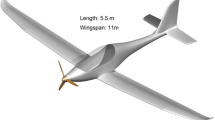Abstract
The design of oscillating foil propulsors is considerably more complex than that of conventional propellers due to the large amount of geometric and kinematic parameters involved in the problem. No general use of such promising propulsion concept is made routinely yet since many open questions remain to be solved. One of such questions is the sensitivity of the propulsor efficiency to foil chord length that is much larger than for conventional propellers. Our focus is on this particular problem. A potential flow theory that estimates the main force components affecting the global performance of such devices is presented. The theory is applied to oscillating foils with heaving and pitching motions and to wheel propellers with foils describing trochoidal paths. Added mass terms that usually are neglected in efficiency analyses and that play an important role in determining the global performance are included. A parameter optimization procedure is introduced in this context. Comparison to experimental data and RANS computations is made.










Similar content being viewed by others
References
van Manen J, van Terwisga T (1997) A new way of simulating whale tail propulsion. In: 21st symposium on naval hydrodynamics
Bose N (2008) Marine power prediction and propulsors. SNAME, New Jersey. ISBN 0939773651
Anderson JM, Streitlien K, Barrett DS, Triantafyllou MS (1998) Oscillating foils of high propulsive efficiency. J Fluid Mech 360:41–72
Read DA, Hover FS, Triantafyllou MS (2003) Forces on oscillating foils for propulsion and maneuvering. J Fluids Struct 17(1):163–183
Hover F, Haugsdal Ø, Triantafyllou M (2004) Effect of angle of attack profiles in flap** foil propulsion. J Fluids Struct 19:37–47
Isogai K, Shinmoto Y, Watanabe Y (1999) Effects of dynamic stall on propulsive efficiency and thrust of flap** airfoil. AIAA J 37(10):1145–1151
Young J, Lai JCS (2004) Oscillation frequency and amplitude effects on the wake of plunging airfoil. AIAA J 42(10):2042–2052
Garrick IE (1936) Propulsion of a flap** and oscillating airfoil. NACA Report No. 567
Cebeci T, Platzer M, Chen H, Chang K-C, Shao JP (2004) Analysis of low-speed unsteady airfoil flows. Springer, Berlin, Heidelberg
Ashraf MA (2010) Numerical simulation of the flow over flap** airfoils in propulsion and power extraction regimes. Ph.D. Thesis, The University of New South Wales at Australian Defence Force Academy, Canberra
Barannyk O, Buckham BJ, Oshkai P (2012) On performance of an oscillating plateu nder water propulsion system with variable chordwise flexibility at different depths of submergence. J Fluids Struct 28:152–166
Vermeiden JG, Kooiker K, Lafeber FH, van Terwisga T, Cerup-Simonsen B, Folsø R (2012) A systematic experimental study on powering performance of flap** foil propulsors. 29th symposium on naval hydrodynamics, Gothenburg, Sweden, 26–31 Aug 2012
Taniguchi K (1962) Sea analysis of vertical axis propellers. In: Proceedings of the 4th symposium on naval hydrodynamics. Office of Naval Research, Washington, pp 429–446
van Manen J, van Oossanen T (1998) Propulsion in principles of naval architecture, vol II. SNAME, Jersey City, pp 127–254
Bartels J-E, Jürgens D (2000) Voith-Schneider-propeller, actual applications and new developments. In: Handbuch der Werften XXVI, Schiffaluns-Verlag, Hamburg (in German)
Jürgens D, Moltrecht T (2002) Enhanced cycloidal propulsion. The International Workboat Show, New Orleans
Dickerson MC, Dobay GF (1975) Experimental performance of some high pitch cycloidal propellers, Report SPD-399-01. David Taylor Naval Ship Research and Development Center, Bethesda, p 45
van Manen J (1973) Non-conventional propulsion devices. Int Shipbuild Progr 20(226):173–193
Bose N, Lai PSK (1989) The experimental performance of a trochoidal propeller with high aspect ratio blades. Mar Technol 26(3):192–201
Veitch BJ (1990) Experimental results and theoretical predictions of trochoidal propeller performance. M.Eng. thesis, Faculty of Engineering and Applied Science, Memorial University of Newfoundland, St. John’s
Li J (1991) Theoretical and experimental study of cycloidal propellers. M.Eng. thesis, Faculty of Engineering and Applied Science, Memorial University of Newfoundland, St. John’s
Brockett T (1991) Hydrodynamic analysis of cycloidal propulsors. In: Proceedings of the propeller Shafting’91 symposium SNAME, Jersey City, NY, pp 127–254
Robert (2013) A tail propulsion system that apes dolphins. In: Yatch and coast. http://www.yachtandcoast.com/featured/a-tail-propulsion-system-that-apes-dolphins/
Katz J, Plotkin A (1991) Low speed aerodynamics: from wing theory to panel methods. McGraw-Hill Series in Aeronautical and Aerospace Engineering, New York. ISBN 0-07-050446-6
Breslin JP, Andersen P (1994) Hydrodynamics of ship propellers. Cambridge university Press, Cambridge. ISBN 0-521-41360-5
Molland AF, Turnock SR (2007) Marine rudders and control surfaces: principles, data and design. Butterworth Heineman, Oxford, p 414
Spera D (2008) Models of lift and drag coefficients of stalled and unstalled airfoils in wind turbines and wind tunnels. NASA/CR-2008-215434
Sánchez-Caja A, Rautaheimo P, Salminen E, Siikonen T (1999) Computation of the incompressible viscous flow around a tractor thruster using a sliding mesh technique. In: 7th international conference in numerical ship hydrodynamics, Nantes, France
Miettinen A, Siikonen T (2015) Application of pressure-and density-based methods for different flow speeds. Int J Numer Methods Fluids 79(5):243–267. doi:10.1002/fld.4051
Acknowledgments
The authors are grateful to the support provided for the research work by the Finnish Funding Agency for Innovation TEKES.
Author information
Authors and Affiliations
Corresponding author
About this article
Cite this article
Sánchez-Caja, A., Martio, J. On the optimum performance of oscillating foil propulsors. J Mar Sci Technol 22, 114–124 (2017). https://doi.org/10.1007/s00773-016-0397-7
Received:
Accepted:
Published:
Issue Date:
DOI: https://doi.org/10.1007/s00773-016-0397-7



